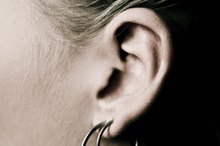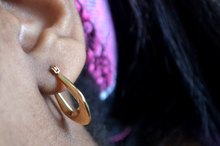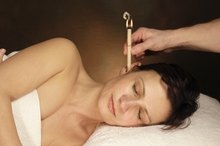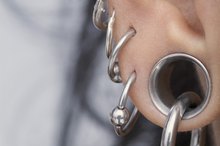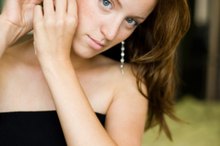Alternatives to Pierced Ears
Risk of infection, fear of the pain or choosing not to pierce your ears because of religious beliefs are all reasons you may want to avoid ear piercing. If you want to decorate your lobes with fashionable accessories, however, you can use pierce-free styles to add a little style to your ears. Before purchasing non-pierced earring styles, check the type of metal used in the earrings to avoid allergic reactions or irritation to the ears.
If you are experiencing serious medical symptoms, seek emergency treatment immediately.
Magnetic Earrings
Magnetic earrings are temporary and affix to the earlobe by two magnets, one on each side of the earlobe. The sides of the magnets that face the earlobe must be opposites to hold the earring in place. The magnet in the front is covered with a decorative object, such as a jewel. Magnetic earrings look the most real and have a longer staying power on the earlobe if the magnet behind the earlobe is attached to a disk earring back. When only a magnet is on the back of the earlobe, sweat may cause the magnet to slip off if not attached to a disk. Worn primarily for fashion, wear magnetic earrings if you want to most closely replicate the look of pierced versions.
- Magnetic earrings are temporary and affix to the earlobe by two magnets, one on each side of the earlobe.
- Magnetic earrings look the most real and have a longer staying power on the earlobe if the magnet behind the earlobe is attached to a disk earring back.
Clip-On Earrings
What to Do When an Ear Grows Over the Back of an Earring
Learn More
Clip-on earrings were invented in the 1930s. Providing a stronger hold than magnetic earrings, the earliest version of clip-on earrings had a screw and clamp mechanism to adhere to the earlobe. Modern clip-on earrings have a clip attached to a hinge on the back of the earring. Attaching the earring consists of pulling the clip back from the earring and sliding onto your earlobe. You may experience pinching or swelling from clip-on earrings if the space between the earring and clip is small and the hinge is tight. Another option is a cuff style earring. Cuff style earrings hug the outer part of the ear and look like jewelry in a cartilage ear piercing.
- Clip-on earrings were invented in the 1930s.
- Modern clip-on earrings have a clip attached to a hinge on the back of the earring.
Spring Action Hoops
Spring action earrings are non-pierced earrings that allow you to wear circular, hoop earrings without an ear piercing. The hoop is not a complete circle and has a spring mechanism opening that retracts while you push the hoop up onto the earlobe. The spring mechanism releases back once the earring is on the earlobe and two pads on each end of the hoop apply pressure to hold the earring in place.
- Spring action earrings are non-pierced earrings that allow you to wear circular, hoop earrings without an ear piercing.
- The hoop is not a complete circle and has a spring mechanism opening that retracts while you push the hoop up onto the earlobe.
Stick-On Earrings
How to Treat an infected ear piercing
Learn More
Stick-on earrings are a novelty type of non-pierced earrings. Available in themed designs, such as cartoon characters, stick-on earrings come on a sheet. Generally marketed toward children, these earrings also are options for adults attending a costume party. An adhesive similar to sticker paper attaches the earring onto the earlobe. There is no backside of the earring 1. These earrings should not be used for extremely young children because the baby or toddler could easily remove the earring and choke if put in their mouth. Children or adults with sensitive skin should not wear stick-on earrings in case of an allergy to the adhesive.
- Stick-on earrings are a novelty type of non-pierced earrings.
- These earrings should not be used for extremely young children because the baby or toddler could easily remove the earring and choke if put in their mouth.
Related Articles
References
- Annie Sherman: History of Vintage Earrings
- She Knows: Alternatives to Piercing Kids' Ears
- Altıntaş A, Çelik M, Yeğin Y, Kayabaşoğlu G. Auricular lobuloplasty. Turk Arch Otorhinolaryngol. 2017;55(4):172-176. doi:10.5152/tao.2017.2675
- Park JK, Kim KS, Kim SH, Choi J, Yang JY. Reconstruction of a traumatic cleft earlobe using a combination of the inverted v-shaped excision technique and vertical mattress suture method. Arch Craniofac Surg. 2017;18(4):277-281. doi:10.7181/acfs.2017.18.4.277
Writer Bio
Maude Coffey retired after 10 years working as a professional body modification artist in the tattoo industry. She is certified in principles of infection control and blood-borne pathogens. Coffey received additional training and classes, such as anatomy, jewelry standards and aftercare, from the Association of Professional Piercers. Coffey aims to educate about safe tattooing and piercing practices while writing for various websites.

